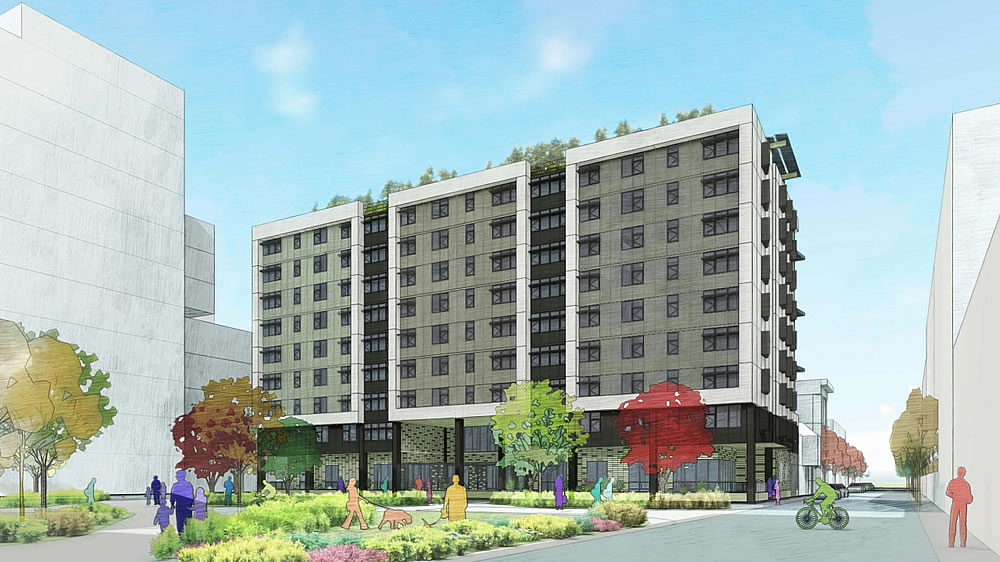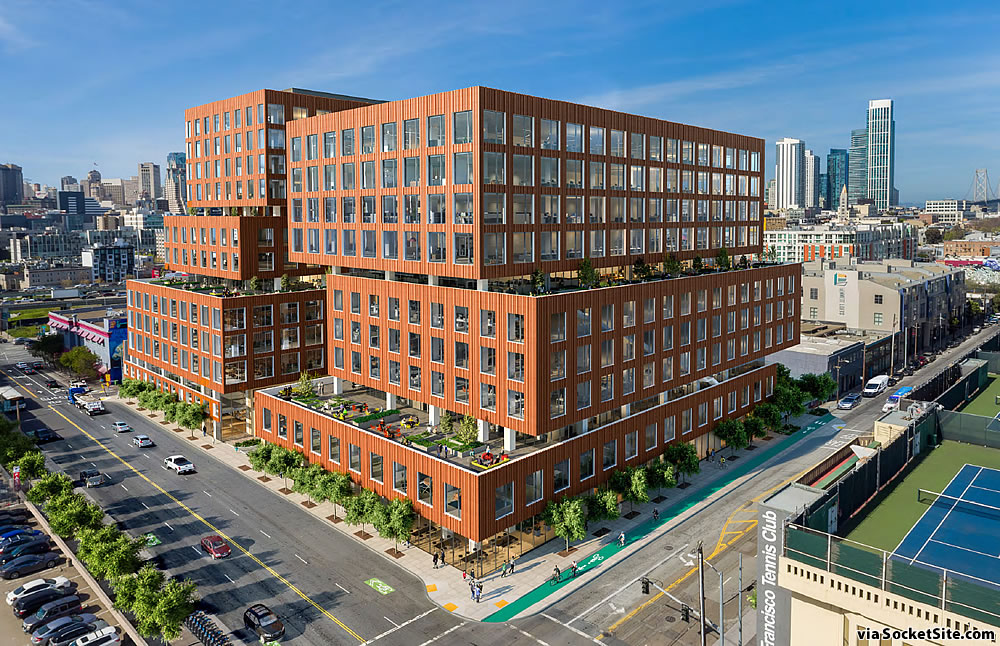The formal application to move forward with the redevelopment of the Central SoMa parking lot parcel at 160 Freelon Street, a 12,800-square-foot parcel which sits behind the approved neighborhood changing development to rise at 598 Brannan and is slated to be deeded to the City to fulfill the affordable housing requirement associated with the larger 598 Brannan project, has been submitted to Planning.
As designed by Leddy Maytum Stacy Architects and Y.A Studio, and to be partially funded by the Mayor’s Office of Housing and Community Development and a Low Income Housing Tax Credit program, the 85-foot-tall, 9-story building will yield 85 below market rate (BMR) apartments, a mix of 15 studios, 24 one-bedrooms, 23 twos and 23 threes.
A quarter of the apartments to rise at 160 Freelon are slated to be rented to formerly homeless families; five units will be set aside for households with a member who is HIV positive; and the remainder of the units are to be rented to low-income families. And assuming everything is approved and funded, Related California, in conjunction with the San Francisco Housing Development Corporation (SFHDC), is now “anticipating” to break ground in 2024.


100% Below Market Rate units?
Doesn’t the new textbook planning theory discourage that kind of housing project, in favor of more diverse demographics and tenant profile?
You seem to have missed the part about “…to fulfill the affordable housing requirement associated with the larger 598 Brannan project” in the post above.
No it doesn’t. There’s nothing about contemporary planning theory or dogma that discourages 100% BMR buildings. You’re thinking about expansive 100% BMR master developments or neighborhoods, like the massive federal housing projects of the early-mid 20th century. In that case, yes, expansive concentrations of poverty without a diversity of incomes, particularly in a model that requires complete ongoing subsidy of an entire neighborhood’s maintenance and infrastructure, including every building, by government subsidy, is a recipe for an unsustainable model.
Also, if you’re building several buildings or a couple blocks, it becomes a financing question of how you’re going to fund construction of the new streets, parks, etc, because the BMR units are not generating any surplus cash to fund that stuff. But that has little to do with the financing, construction, and operation of single individual buildings, which is generally how the vast majority of affordable housing is funded, built, and operated.
The grey area is when you start talking about really large 100% BMR buildings, which haven’t been built in a long time in most places, like huge tower with only BMR units, where you start running into similar issues as you get for the old housing projects. Though some non-profit affordable housing outfits are starting to dip a toe towards bigger buildings, somewhat tentatively and with an eye toward better design and broader range of incomes. But high-rises are just more expensive and complicated to build, and the scale of affordable housing funding is such that it’s much more doable to finance buildings in the 75-200 unit scale that aren’t high rises.
should have more studios. Of large cities, San Francisco has the highest percentage of non-family homelessness (91%), meaning the SF homeless population is largely single men and women.
So can this be built without the 598 Brannan project proceeding, right? Since it sounds like the city is partially funding it. And then the 598 Brannan project can go forward (built or sold or held) without any BMR requirements attached? After all, now is probably not a great time to build a huge SOMA residential property.
Gaaaawd this architecture is such garbage
Agree! This has banality written all over it.
Just a bit linguistic pedantry: We seem to be using the term BMR as a catchall for affordable housing when what we seem to be talking about here is assisted low-income housing, and not the BMR condo program. I realize it’s all below market rate (lower case) housing being discussed but since I’ve never heard the term BMR in other markets I always assumed it referred to that specific MOHCD program. Am I off base here?
“Guided by San Francisco Planning Code Section 415, the Inclusionary Housing Program (also known as “Below-Market-Rate Program”) aims to create housing affordable to low, moderate, and or middle income households in new buildings. When a housing developer proposes a residential project with 10 or more units, they must either:
1. Reserve a percentage of units in the new building to be rented or sold at a below market rate
2. Reserve a percentage of units in another building they build to be rented or sold at a below market rate
3. Pay a fee
4. Dedicate land that will become affordable housing
5. [Or Provide] A combination of all the above
The San Francisco Planning Department works with housing developers to determine the number of reserved units or fees. MOHCD is brought on before the building can be occupied to price the units and oversee the marketing and application process. The application includes a public lottery for the units.
The program currently includes over 3,000 affordable units throughout San Francisco.”